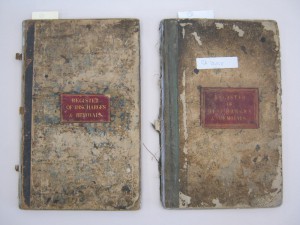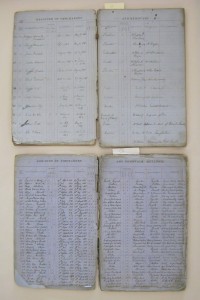This blog is brought to you by Explore Your Archives week and is the second on Continuity of Care – the project to catalogue and conserve the records of the Royal Scottish National Hospital. Thanks to a grant from the Wellcome Trust, this project started in the middle of August and will be completed by July 2015.
The project includes funding for a conservator and Liz Yamada started in the post in September. She has already surveyed the collection and identified items which need conservation work. Of particular interest are the first two Registers of Discharges and Removals.

The volumes record where children were sent after leaving the Institution. They record information on the length of stay in asylum and more interestingly the condition of the child – whether recovered, relieved, not improved or incurable. As the photograph shows although all the children are discharged as ‘not improved’ the observations tell a different story.
But this blog entry is about the conservation of the items rather than their archival content.


They look very similar from the outside but could be conserved in very different ways. It is likely that the first volume, covering 1864-81, will be conserved in a conventional way: the pages will be cleaned with a latex sponge; the edges and spine folds repaired with Japanese paper and wheat starch paste; the binding re-sewn; and the old cover re-attached and consolidated so that it continues to be used as a book. The second volume, covering 1881-1915, on the other hand, is likely to be disbound, the pages put in polyester sleeves and stored in a folder with the detached cover.

Why the difference in approach? The second volume could be repaired in the same way as the first but it would be more difficult, hence more time consuming and as a result, much more costly. One of the crucial differences between the two volumes is that the paper used for volume 13 is more brittle and as a result, many of the folds have cracked, so most of the pages are now single sheets. Another key difference is that the text is very close to the page edges and there are lots of edge tears in those areas. Very light Japanese paper would need to be used for repair so that the text is visible through it. This would not be very strong and would necessitate repairing both sides which doubles the repair time. The Japanese paper used for conservation is generally cream in colour so it will always stand out on blue paper originals. Although this is not detrimental to the preservation of the item, it is not very attractive. The repair papers could be toned blue with acrylic paints before they are applied but again, this adds to the repair time. Placing the pages in polyester sleeves will ensure that the pages can be handled without losing further information and can be preserved without the need for repair. Should it be necessary or desirable to carry out full repairs on the volume in the future, this will still be entirely possible.
Polyester sleeves are completely inert and a useful tool for the long-term preservation of many paper-based items. They protect items physically from being torn or creased and in some cases protect them chemically from items that give off damaging fumes. However, they cannot be used for everything in an archive collection. The cost of sleeves can add up quite quickly as can the weight which can impact on boxing, shelving floor loadings and archive staff who have to carry the boxes. They also add bulk, taking up valuable storage space. Polyester also carries static so it is not suitable for friable (powdery) media such as pastel, charcoal and soft pencil because it can lift the image off the paper. Sleeving items also changes the feel of the item, the smell and the overall appearance which is not necessarily desirable.